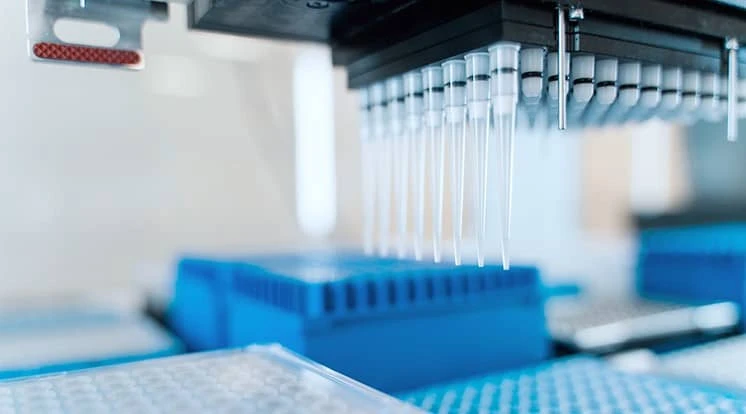
52869_iStock-1297150635_m
Since the beginning of the coronavirus crisis at the latest, the pharmaceutical industry and laboratories have been under pressure to realize the highest possible levels of automation – from new analysis and testing devices to production lines, and filling/packaging systems. This efficiency is dependent on the level of automation and miniaturized linear motor axes and modules for single- or multi-axis applications open new possibilities. Designed as a modular system, they are suitable for a wide range of tasks in laboratory automation and the pharmaceutical industry. They are powered by FAULHABER linear motors.

The engineers from Jung Antriebstechnik u. Automation GmbH JA² responded to calls from the pharmaceutical industry, the analysis sector, and the medical technology industry for small but functional automation solutions with the development of a new modular mechatronic system called QuickLab. With the small QM02 linear motor modules for up to 160mm of stroke and the QA02 linear motor axes for strokes up to 220mm, short-stroke applications can be realized with high dynamics and accuracy. Through the mechanical construction and precision guides in combination with two ball carriages, the modules and axes are very stiff and offer high repeatability during positioning of ±50µm despite their lightweight construction and low moving mass. Depending on the load, travel speeds up to 3m/s and accelerations up to 50m/s² are possible. The axes and modules can be individually combined with one another, so pick-and-place applications can be realized as can automatic solutions for separating, grouping, testing, or plating samples or other sensitive products. With a width of 22mm, QuickLab perfectly covers the need for miniaturized single- and multi-axis handling systems. Moreover, the appropriate accessories such as weight force compensation, magnetic holding brakes, external position sensors and adapter plates are offered.

High dynamics and precision
"The linear motors are the heart of our modular automation system and the requirements placed on them are very high," explains Wilhelm Jung, managing director at JA². "The motors must operate highly dynamically, be precisely controllable, and have suitable dimensions. The linear motors from FAULHABER convinced here with their innovative functional principle, which differs from classic solutions.”
Linear motors can be constructed in several different ways because all principles of rotating electric motors can generally be implemented in linear motors by mapping the round air gap onto a straight line. To do this, the originally circularly arranged electric excitation windings are mapped on a flat path. The magnetic field then pulls the rotor over the travel path. There are, however, still other possibilities: The LM2070 DC linear drives aren’t constructed as such surface rotors with carriage and guide. Instead, the forcer rod is guided within a 3-phase self-supporting coil.
"This design produces an exceptionally good relationship between linear force and current and high dynamics. In addition, there are no cogging torques, thereby making the linear motors ideal for use in our modular QuickLab system,” Jung says.
Maximum performance in the smallest dimensions
The LM2070 linear motors are available with stroke lengths from 40mm to 220mm. Despite the compact stator dimensions of 20mm x 20mm x 70mm (W x H x L), the small linear DC servomotor has impressive mechanical performance indicators. The continuous force is 9.2N, and up to 28N of peak force is available. The robust plain bearing of the forcer rod easily handles the high speeds of up to 3 m/s. At the same time, the small powerhouse can be very precisely controlled. Already with the integrated Hall sensors, the absolute positioning accuracy is ±0.1mm and the repeatability is ±50µm. With an optional external sensor, these figures can be improved to ±0.01mm and a repeatability of ±1µm. On top of this comes practically maintenance-free operation as the motor has no moving wear parts. Moreover, the linear drive operates nearly noise-free. "This is important above all if personnel and handling systems work in the same room, as is often the case in laboratories," Jung adds.
Trailing-chain cable connection
An important point for handling systems is the connection technology. The linear motors are normally delivered with a max. 30cm long cable connection. In automation systems, however, the switch cabinet is usually some distance from the actual drive.
"Between the motor and the controller in the separate switch cabinet, there can then be 10, 20 or more meters," Jung says.
With the QuickLab modular system, there is therefore a special, multi-shielded cable that transfers the motor power and the position sensor signal between motor and controller interference-free over up to 30m. It is fastened with a cover directly to the motor with strain relief, can be plugged in and is also designed for use with cable chains, i.e., for mobile use. The single-cable technology simplifies installation thanks to the prefabrication of both ends.
The mechatronic kit tailor made for laboratory automation has already proven itself in practical use.
"Many manufacturers and suppliers of analysis accessories today rely on our systems. Demand is currently enormous – including from other areas such as optics and testing technology," Jung says.
Always present as the driving force: the small, powerful LM2070 linear drives.
Latest from Today's Medical Developments
- Arcline to sell Medical Manufacturing Technologies to Perimeter Solutions
- Decline in German machine tool orders bottoming out
- Analysis, trends, and forecasts for the future of additive manufacturing
- BlueForge Alliance Webinar Series Part III: Integrate Nationally, Catalyze Locally
- Robot orders accelerate in Q3
- Pro Shrink TubeChiller makes shrink-fit tool holding safer, easier
- Revolutionizing biocompatibility: The role of amnion in next-generation medical devices
- #56 Lunch + Learn Podcast with Techman Robot + AMET Inc.





